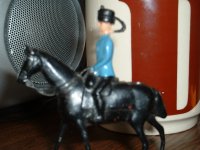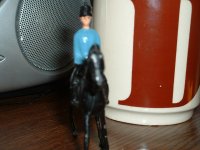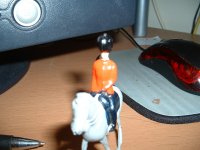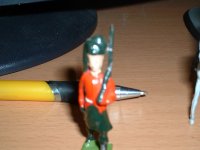Finally I get a few metal soldiers but it seems whoever painted them did a very poor job. I need some basic outlines on how to repaint them. There are 3 altogether 2 mounted on horses one highlander with a rifle. My question is how do you get the paint off without hurting any details? Also any recommendations on tools such as brushes paint and any tips will help. I did paint Dungeon and dragons and Ral Partha figures years ago (Over 30) and the technique I used was start with skin and work outwards. Does this still hold true? any help is greatly appreciated. Thank you. -Dan-
You are using an out of date browser. It may not display this or other websites correctly.
You should upgrade or use an alternative browser.
You should upgrade or use an alternative browser.
New guy needs help with painting basics (1 Viewer)
- Thread starter Salem
- Start date
Hazebrouck
Sergeant
- Joined
- Aug 30, 2010
- Messages
- 633
Hi Dan,
I strip and repaint a few old metal figures. You could try turps or white spirit first as that occasionally removes paint. More often than not I use a commercial paint stripper and a toothbrush. Give the stripper some time to work and scrub with a tooth brush. You may have to do it twice (remember to wear rubber gloves and watch for fumes) and then wash thoroughly with water and some detergent.
Stripping the paint will actually reveal the detail. Priming the figure will also bring out the detail.
I use that painting technique of face, hands and legs (sometimes) mostly and then block with main clothing colours and then smaller details. Others paint differently though and I guess it is something you can experiment with, as with paint types and styles (acrylic, enamels, gloss or matt) till you find something that works for you.
I have found this series of videos good, particularly for painting faces-
http://www.youtube.com/watch?v=AJuQvVjdNCA
Just have a go and don't worry about making a few mistakes.
Scott
I strip and repaint a few old metal figures. You could try turps or white spirit first as that occasionally removes paint. More often than not I use a commercial paint stripper and a toothbrush. Give the stripper some time to work and scrub with a tooth brush. You may have to do it twice (remember to wear rubber gloves and watch for fumes) and then wash thoroughly with water and some detergent.
Stripping the paint will actually reveal the detail. Priming the figure will also bring out the detail.
I use that painting technique of face, hands and legs (sometimes) mostly and then block with main clothing colours and then smaller details. Others paint differently though and I guess it is something you can experiment with, as with paint types and styles (acrylic, enamels, gloss or matt) till you find something that works for you.
I have found this series of videos good, particularly for painting faces-
http://www.youtube.com/watch?v=AJuQvVjdNCA
Just have a go and don't worry about making a few mistakes.
Scott
theBaron
Major
- Joined
- Mar 27, 2008
- Messages
- 10,467
Hi, Salem,
For removing paint, I recommend SuperClean, an automotive de-greaser. You should be able to find it at automotive suppliers or hardware stores. Here in the States, it's also sold at WalMart and other discount department stores. It has a couple of advantages. It's relatively non-toxic and free of fumes, it removes paint--enamel, acrylic or oil, will also remove chrome from chromed pieces, and you can use a batch of it over and over. I fill a jar of appropriate size for the figure I want to clean, and place the figure in it. After a couple of minutes, the paint is softened and can be removed with an old toothbrush. I usually let pieces soak longer, while I work on something else. I have left one figure in a jar for days, and the paint had softened and dissolved into the solution.
SuperGreen is another cleaner that some folks use, that works in similar fashion to SuperClean. It's supposed to be environmentally-friendly, if that's something you're looking for.
I used to use oven cleaner, but that was a pain because it's so caustic.
As far as damaging details goes, I find that the damage comes more from the scrubbing process, than the dissolving process, so it pays to be careful.
As far as painting sequence goes, there's not one right or wrong way, but pretty much the way that works best for you. But yes, many painters, especially those painting to a connoisseur standard, tend to start with flesh, but that's more on the principle of starting on the inside and working outward. I do tend to paint base colors on large areas first, and then the face, then the other external details (equipment, insignia, the hands, etc).
Hope that helps, and I look forward to seeing some photos of your project.
Prost!
Brad
For removing paint, I recommend SuperClean, an automotive de-greaser. You should be able to find it at automotive suppliers or hardware stores. Here in the States, it's also sold at WalMart and other discount department stores. It has a couple of advantages. It's relatively non-toxic and free of fumes, it removes paint--enamel, acrylic or oil, will also remove chrome from chromed pieces, and you can use a batch of it over and over. I fill a jar of appropriate size for the figure I want to clean, and place the figure in it. After a couple of minutes, the paint is softened and can be removed with an old toothbrush. I usually let pieces soak longer, while I work on something else. I have left one figure in a jar for days, and the paint had softened and dissolved into the solution.
SuperGreen is another cleaner that some folks use, that works in similar fashion to SuperClean. It's supposed to be environmentally-friendly, if that's something you're looking for.
I used to use oven cleaner, but that was a pain because it's so caustic.
As far as damaging details goes, I find that the damage comes more from the scrubbing process, than the dissolving process, so it pays to be careful.
As far as painting sequence goes, there's not one right or wrong way, but pretty much the way that works best for you. But yes, many painters, especially those painting to a connoisseur standard, tend to start with flesh, but that's more on the principle of starting on the inside and working outward. I do tend to paint base colors on large areas first, and then the face, then the other external details (equipment, insignia, the hands, etc).
Hope that helps, and I look forward to seeing some photos of your project.
Prost!
Brad
Thanks for the pointers. We have Walmart in town here but the Canadian standards may be a bit different but I will look for the stuff for sure. I will get some photos up before I start, during and after. I seemed to have gotten hooked on these little guys! :smile2:
Ok so you can see though the pictures are blurred a bit ... ok a lot that there is no detail on these figures. I hope to add some after I strip them. The figures have little to no detail on the uniforms or the horses. Now please remember these are my first miniature anything in years. I lost all my collectables in a fire a year ago and this new venture should be therapeutic for me. Or it could drive me totally nuts either way it will be a wild ride. Normally I would add the detail myself over the paint but I have no clue what type of paint this is so I feel it would be best to take them down to metal, prime them and start over. The mood marks say Made in England and Britians followed by a huge splot of paint that covers what appears to be a symbol of some type. Any help identifying these would be a huge help. Not a bad deal I paid 10 dollars for all three with no tax.
Hazebrouck
Sergeant
- Joined
- Aug 30, 2010
- Messages
- 633
Salem,
They are basic old Britains and you are not likely to lose any detail stripping them back. I would strip and repaint them in gloss enamels.
Have a look through some of forum member JohnnyBachs threads for painting tips with these types of figures, particularly the tartans. He knows his stuff!
Scott
They are basic old Britains and you are not likely to lose any detail stripping them back. I would strip and repaint them in gloss enamels.
Have a look through some of forum member JohnnyBachs threads for painting tips with these types of figures, particularly the tartans. He knows his stuff!
Scott
theBaron
Major
- Joined
- Mar 27, 2008
- Messages
- 10,467
I think you'll find, once you've got the paint off them, that they are elegantly simple castings. They afford you the opportunity to add as much or as little detail as you would like. I agree with Scott, these will look great with a new coat of gloss.
Now, get the brushes and get to work!
Prost!
Brad
Now, get the brushes and get to work!
Prost!
Brad
I think you'll find, once you've got the paint off them, that they are elegantly simple castings. They afford you the opportunity to add as much or as little detail as you would like. I agree with Scott, these will look great with a new coat of gloss.
Now, get the brushes and get to work!
Prost!
Brad
I bought the superclean and it worked great. Yes you were right these are simple but elegant castings and really I enjoy them . I started stripping two days ago and yesterday started with the painting. So far so good I am using Testors enamel. I actually had to drive to the next town to buy these paints at 2 bucks a bottle. Far cry from the 75 cents I use to pay. I also picked up another Britians there that is on my other thread. For 5 bucks I got a 1 armed captain so I am looking for an arm for him. Pictures to follow soon.
johnnybach
Major General
- Joined
- Nov 24, 2010
- Messages
- 13,663
I bought the superclean and it worked great. Yes you were right these are simple but elegant castings and really I enjoy them . I started stripping two days ago and yesterday started with the painting. So far so good I am using Testors enamel. I actually had to drive to the next town to buy these paints at 2 bucks a bottle. Far cry from the 75 cents I use to pay. I also picked up another Britians there that is on my other thread. For 5 bucks I got a 1 armed captain so I am looking for an arm for him. Pictures to follow soon.
Glad to see that you're enjoying painting your "new" - old Britains finds. Great stuff - welcome to the Club.
One little tip - that I learned when posting pics. Try and put a sheet of white paper - or something like it - behind your figures when you take a quick snap. This stops the camera focussing on all of the background bits and pieces - instead of what you want to show up clearer - your figures.
I learned this myself - through trial and error. Will look forward to seeing your final results - and don't worry about them - they'll be fine.:wink2: johnnybach
Users who are viewing this thread
Total: 2 (members: 0, guests: 2)





